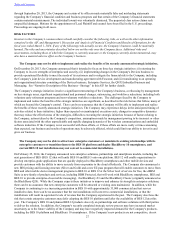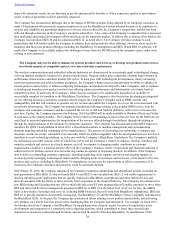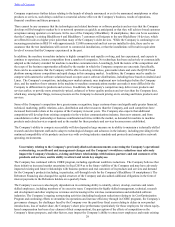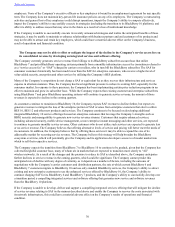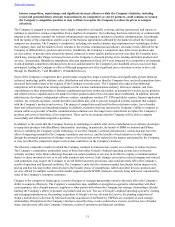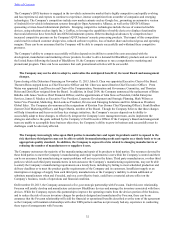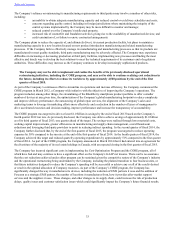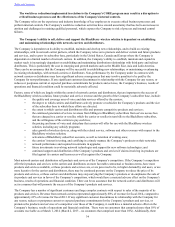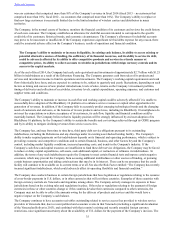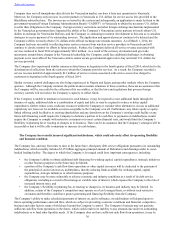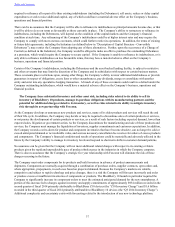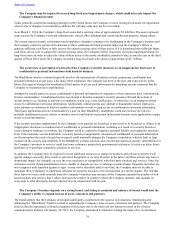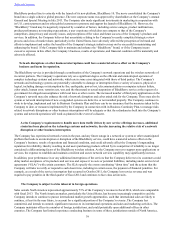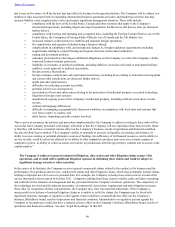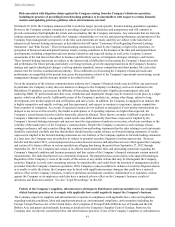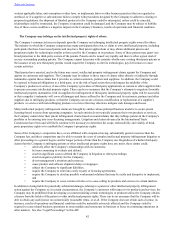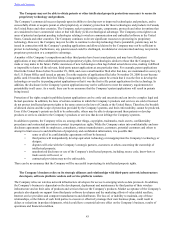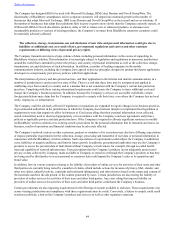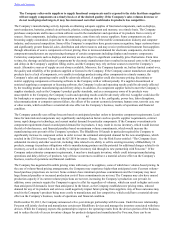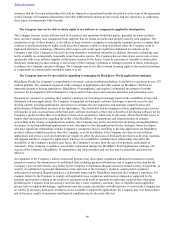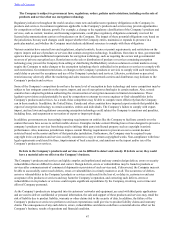Blackberry 2014 Annual Report Download - page 45
Download and view the complete annual report
Please find page 45 of the 2014 Blackberry annual report below. You can navigate through the pages in the report by either clicking on the pages listed below, or by using the keyword search tool below to find specific information within the annual report.
37
required to refinance all or part of its then existing indebtedness (including the Debentures), sell assets, reduce or delay capital
expenditures or seek to raise additional capital, any of which could have a material adverse effect on the Company’s business,
operations and financial position.
There can be no assurance that the Company will be able to refinance its indebtedness as principal amounts become due, or that
it will be able to do so on terms as favourable as those currently in place. The Company’s ability to restructure or refinance its
indebtedness, including the Debentures, will depend on the condition of the capital markets and the Company’s financial
condition at such time. Any refinancing of the Company’s indebtedness could be at higher interest rates and may require the
Company to comply with more onerous covenants, which could further restrict its operations. In addition, the terms of existing
or future debt agreements, including the Indenture (as defined below in “Description of Capital Structure - Convertible
Debentures”), may restrict the Company from adopting any of these alternatives. Further, upon the occurrence of a Change of
Control (as defined in the Indenture), the Company would be obliged to make an offer to purchase the outstanding Debentures
at a premium, which would require the Company to secure capital. If the Company is unable to refinance its indebtedness, or is
only able to refinance indebtedness on less favourable terms, this may have a material adverse effect on the Company’s
business, operations and financial position.
Certain of the Company’s indebtedness, including the Debentures and the asset-backed lending facility, is subject to restrictive
and other covenants that may limit the discretion of the Company and its subsidiaries with respect to certain business matters.
These covenants place restrictions upon, among other things, the Company’s ability to incur additional indebtedness or provide
guarantees in respect of obligations, create liens or other encumbrances, pay dividends, merge or consolidate with another
entity and enter into any speculative hedging transaction. A breach of any of these covenants could result in a default under the
Company outstanding indebtedness, which would have a material adverse effect on the Company’s business, operations and
financial position.
The Company faces substantial inventory and other asset risk, including risks related to its ability to sell its
inventory of BlackBerry 10 products, manage its purchase obligations with its manufacturing partners and the
potential for additional charges related to its inventory, as well as risks related to its ability to mitigate inventory
risk through its new partnership with Foxconn.
As the Company develops or announces new products and services, many of its older products and services will reach the end
of their life cycle. In addition, the Company may decide or may be required to discontinue sales of certain products or services,
or not pursue the development of certain products or services, as a result of such factors including expected demand, lower than
expected sales, litigation or government action. As the Company discontinues the manufacturing and sale of these products and
services, the Company must manage the liquidation of inventory, supplier commitments and customer expectations. In addition,
the Company records a write-down for product and component inventories that have become obsolete, can no longer be sold or
exceed anticipated demand or net realizable value, and accrues necessary cancellation fee reserves for orders of excess products
and components. The Company’s financial condition and results of operations could be materially and adversely affected in the
future by the Company’s ability to manage its inventory levels and respond to short-term shifts in customer demand patterns.
No assurance can be given that the Company will not incur additional related charges with respect to its existing or future
products given the rapid and unpredictable pace of product obsolescence in the industries in which the Company competes.
There is also no assurance that the Company’s strategic five year relationship with Foxconn will eliminate the risk of these
charges occurring in the future.
The Company must order components for its products and build inventory in advance of product announcements and
shipments. Components are normally acquired through a combination of purchase orders, supplier contracts, open orders and,
where appropriate, prepayments, in each case based on projected demand. Because the Company’s markets are volatile,
competitive and subject to rapid technology and price changes, there is a risk the Company will forecast incorrectly and order
or produce excess or insufficient inventories of components or products. The BlackBerry 10 launch in particular required the
Company to significantly increase its component orders to meet the estimated anticipated demand for the new smartphones. A
portion of this increase led to charges against inventory and supply commitments of approximately $934 million recorded in the
second quarter of fiscal 2014 primarily attributable to BlackBerry Z10 devices (the “Z10 Inventory Charge”) and $1.6 billion
recorded in the third quarter of fiscal 2014 primarily attributable to BlackBerry 10 devices (the “Q3 2014 Inventory Charge”).
Additional complexity and uncertainty exists with forecasting related to the introduction of any new technology platform.
Table of Contents


